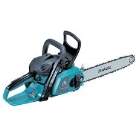Historical Products
Engineering Report
The Chainsaw
Introduction
A chainsaw is one of the most powerful tools in the timber industry. It is a lightweight, hand-held mechanical saw, used for cutting logs or timber. Chainsaws can either be powered by petrol or electricity and can range from a backyard tool device, to professional levels in the fire industry or chopping large quantities of wood. This report on ‘Chainsaws’ will allow you to develop a better understanding on its history, effects on society, materials, mechanical and engineering properties.
Mechanical Property – Automatic Oiler
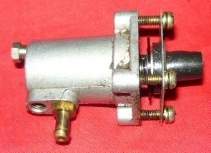 A modern chainsaw consists of many new materials that older versions of chainsaws never had before. For example, automatic oilers were created a few decades after the invention of timber cutting chainsaws and advanced the safety of chainsaws. It allowed the fast spinning metal chain to be constantly lubricated. Lubrication on the bar is needed constantly and if it is improperly maintained, it will cause serious friction making the bar quickly heat up, potentially bend and can cause a lot of damage to the chain.
A modern chainsaw consists of many new materials that older versions of chainsaws never had before. For example, automatic oilers were created a few decades after the invention of timber cutting chainsaws and advanced the safety of chainsaws. It allowed the fast spinning metal chain to be constantly lubricated. Lubrication on the bar is needed constantly and if it is improperly maintained, it will cause serious friction making the bar quickly heat up, potentially bend and can cause a lot of damage to the chain.
Automatic Oil Pump
https://store.chainsawr.com/products/echo-cs-60s-chainsaw-oil-pump-oiler
Engineering Principle – Centrifugal Clutch
The Centrifugal Clutch on the chainsaw is one of the key components. It is the link that connects the engine and the chain. The purpose of the clutch is to stop the chain spinning while the engine is idling. When the operator pulls the throttle trigger, the clutch engages by the high friction material on the shoes pressing against the high friction material on the drum outer casing. This causes the centrifugal force on the shoes making them come in contact with the drum outer casing to spin at extremely fast RPM. Advantages of a centrifugal clutch is its automatic, slips automatically to avoid stalling the engine and it lasts forever.
Centrifugal Force Diagramhttps://www.engineeringclicks.com/centrifugal-clutch/
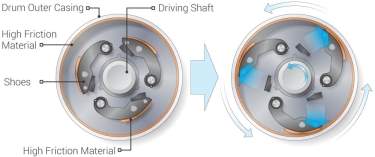
Materials
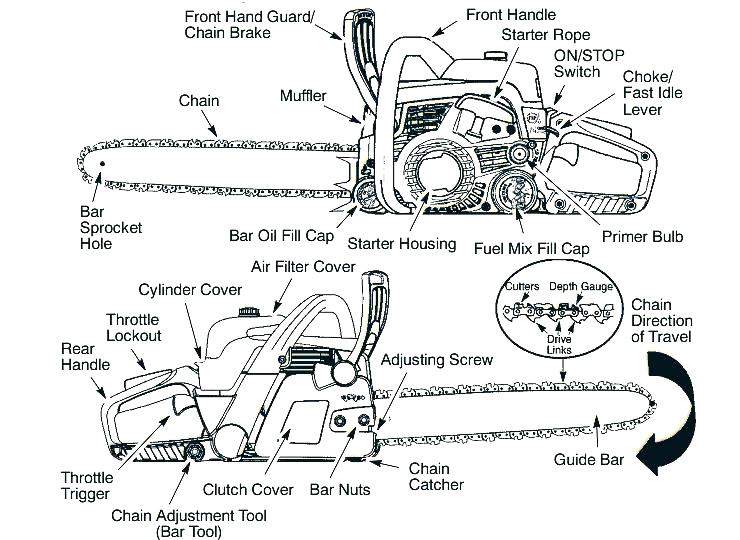
As seen in the image above, a chainsaw is made out of many different components that allows it run. Some parts are used to improve safety (such as the hand guard, brake, anti-vibration handle and 4 others) and crucial parts (such as the chain and guide bar). The bar of the chainsaw is always made out of steel, and the covering is usually made out of plastic to make the chainsaw lighter in weight.
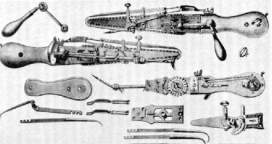 History
History
The chainsaw, hasn’t always been used for cutting down trees. In the 1780’s two Scottish doctors invented a chain that carried out repetitive movements through alternated pulling, to making cutting during Symphysiotomies (widening the pelvis allowing childbirth) more precise. Later on, an orthodontist named Berhard Heine improved the Scottish doctor’s invention.
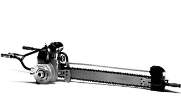 The first machine to put an end to manual forest work was invented in 1926 by the Stihl company. It was a two-man saw which weighed 48kg and was used in mill yards. This was later on improved by Andreas Stihl in 1929. He created the first chainsaw with a petrol engine, it weighed a total of 46kg and a power output of 6 HP which was a lot for its time.
The first machine to put an end to manual forest work was invented in 1926 by the Stihl company. It was a two-man saw which weighed 48kg and was used in mill yards. This was later on improved by Andreas Stihl in 1929. He created the first chainsaw with a petrol engine, it weighed a total of 46kg and a power output of 6 HP which was a lot for its time.
tree-felling machine
https://www.stihl.com.au/static/geschichte/images/produkt/1920_1929/baumfaellmaschine.jpg
In the middle of 1948, a newly designed chainsaw was invented, which was shaped like the original 1920’s bow saw, although this was more powerful and could be used by one operator. Just under 2 years after this invention, the first petrol-driven chainsaw for a single operator was invented. It weighed less then 16kg and was able to manually adjust swivel carburettor. This allowed the saw to be used for both bucking and now newly felling.
The two-stroke diesel engine for chainsaws was later applied in 1954 by Stihl. This increased its thermal efficiency resulting in less heat being transferred to the combustion chamber surface. Since 1954, Chainsaws have kept the same designs, but have improved on many features (e.g. easy removal caps).
The Electric chainsaw was invented in the 1960s and has been used for domestic level of work. It is used by many domestic users today because of low difficulty while using the chainsaw, but less powerful then the petrol driven chainsaws.
Impact of Chainsaws in the timber industry
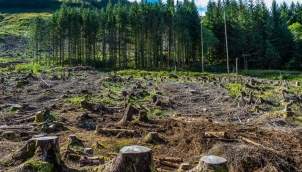 Chainsaws have been a revolutionary product in the timber industry in both positives and negatives ways. Although there are only a few positives, chainsaws have become one of the top tools to use for gardening and mass production of cutting down trees. This is because of its efficiency, speed and near effortless use, unlike the old fashion hand held saw. This has made mass cutting timber extremely easy to do and allowed big production companies to sell wood to clients quicker and at a low-cost.
Chainsaws have been a revolutionary product in the timber industry in both positives and negatives ways. Although there are only a few positives, chainsaws have become one of the top tools to use for gardening and mass production of cutting down trees. This is because of its efficiency, speed and near effortless use, unlike the old fashion hand held saw. This has made mass cutting timber extremely easy to do and allowed big production companies to sell wood to clients quicker and at a low-cost.
Disadvantages of the chainsaw in society, is it has contributed 65-70% of all timber cut in the world (46% of all trees in the world according to National Geographic). This is alarming numbers, and if we continue at the current rate of cutting down trees (10 billion trees per year) the Earth will become tree-less in the next 300 years.
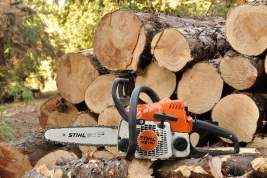 Furthermore, a census data from a forestry industry was taken in the year 1951 and recorded that 10333 people worked as loggers. The same census was given out again 10 years later and the number of loggers had dropped to 6711. Heritage NEWFOUND & LABRADOUR qoutes, ‘operators began to rely less on manpower and more on machinery to harvest timber’. This quote perfectly fits with what was said above due to the loss of jobs.
Furthermore, a census data from a forestry industry was taken in the year 1951 and recorded that 10333 people worked as loggers. The same census was given out again 10 years later and the number of loggers had dropped to 6711. Heritage NEWFOUND & LABRADOUR qoutes, ‘operators began to rely less on manpower and more on machinery to harvest timber’. This quote perfectly fits with what was said above due to the loss of jobs.
Recommendations
With hundreds of chainsaws on the market the decision to choose between an Electric or Petrol powered chainsaw can sometimes be hard. Below is a table comparing the two types:
|
Chainsaw |
Advantages |
Disadvantages |
|
Electric MSE C-B https://www.stihl.com.au/STIHL-Products/Chainsaws/Electric-Chainsaws/22330-1574/MSE-170-C-B.aspx |
-Useful for light work (Domestic) -Not as loud as the Petrol -Less maintenance -Lighter in weight |
-Not as powerful as petrol chainsaw |
|
Petrol
Makita 2 Stroke https://www.bunnings.com.au/makita-32cc-2-stroke-40cm-bar-petrol-chainsaw_p3380492 |
-Stronger, More powerful -Professional levels |
-Very noisy -More maintenance |
The choice between both chainsaws can depend on your situation. If you are only using it for domestic uses, the best option is to buy an electric powered chainsaw. If you are using the chainsaw on a professional level, a petrol powered chainsaw would be the best option as it is more powerful.
Both chainsaws need to be maintained correctly (more so the petrol) with either chainsaws lasting a long amount of time. Both chainsaws can start at less the $50 and can work their way up to over $3000 (professional level)
Conclusion
To conclude, chainsaws have been revolutionary to the timber industry since the beginning. They have had several negative effects to the environment (such as deforestation) and positive effects towards our lives (use in the fire department). With chainsaws being an affordable and easy to use product, I highly recommend buying a chainsaw instead of a manual saw, for removal or trimming of bushes or trees.
References
- Anon, (2019). Impacts of Chainsaws. [online] Available at: https://www.heritage.nf.ca/articles/economy/mechanization-impacts.php [Accessed 16 Feb. 2019].
- Garden, H., Garden, H., Improvement, H. and Materials, T. (2019). How Chain Saws Work. [online] HowStuffWorks. Available at: https://home.howstuffworks.com/chainsaw4.htm [Accessed 16 Feb. 2019].
- Lowimpact.org. (2019). Chainsaws – Lowimpact.org. [online] Available at: https://www.lowimpact.org/lowimpact-topic/chainsaws/ [Accessed 18 Feb. 2019].
- Reign, A. (2019). A Brief History of Who Makes the Best Chainsaw in the World. [online] The Wood Cutter. Available at: https://thewoodcutter.info/history-evaluation-of-the-chainsaw/ [Accessed 17 Feb. 2019].
- Remondo, A. (2019). Deforestation. [online] Global Warming. Available at: https://www.nationalgeographic.com/environment/global-warming/deforestation/ [Accessed 15 Feb. 2019].
- Smith, A. (2019). STIHL – History. [online] Stihl.com.au. Available at: https://www.stihl.com.au/static/geschichte/vor1900.htm [Accessed 11 Feb. 2019].
- Ty’s Outdoor Power. (2019). Andreas Stihl: The Man Behind the Brand – Ty’s Outdoor Power. [online] Available at: https://tysoutdoorpower.com/andreas-stihl-man-behind-brand/ [Accessed 13 Feb. 2019].
- WSL, E. (2019). The History of the Chainsaw. [online] Waldwissen. Available at: https://www.waldwissen.net/lernen/forstgeschichte/wsl_geschichte_motorsaege/index_EN [Accessed 13 Feb. 2019].
Cite This Work
To export a reference to this article please select a referencing style below:


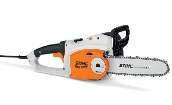 Electric
Electric
